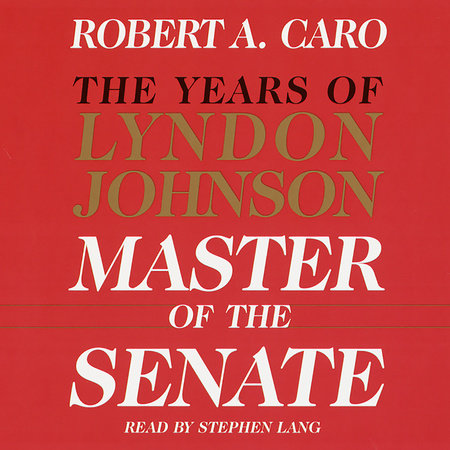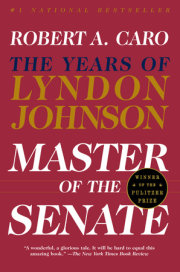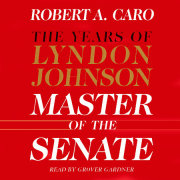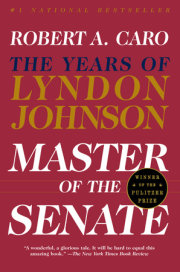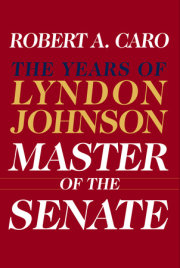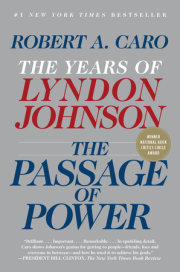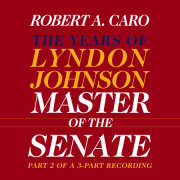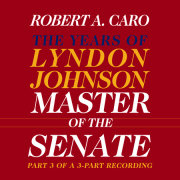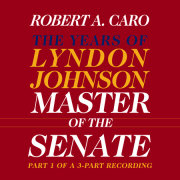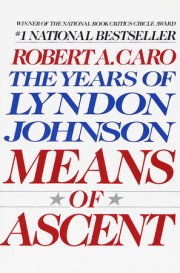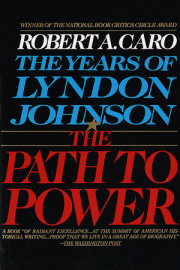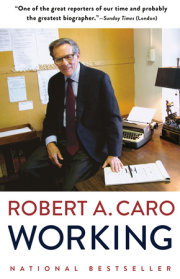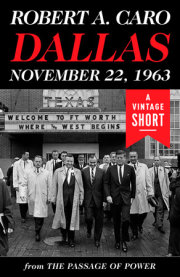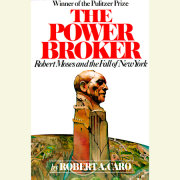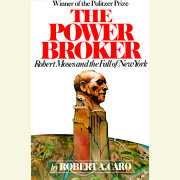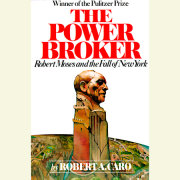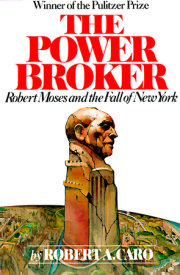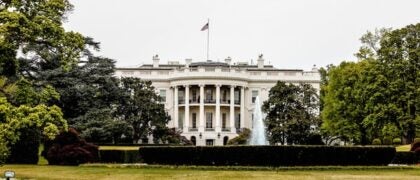Chapter 1
The Desks of the Senate The Chamber of the United States Senate was a long, cavernous space—over a hundred feet long. From its upper portion, from the galleries for citizens and journalists which rimmed it, it seemed even longer than it was, in part because it was so gloomy and dim—so dim in 1949, when lights had not yet been added for television and the only illumination came from the ceiling almost forty feet above the floor, that its far end faded away in shadows—and in part because it was so pallid and bare. Its drab tan damask walls, divided into panels by tall columns and pilasters and by seven sets of double doors, were unrelieved by even a single touch of color—no painting, no mural—or, seemingly, by any other ornament. Above those walls, in the galleries, were rows of seats as utilitarian as those of a theater and covered in a dingy gray, and the features of the twenty white marble busts of the country’s first twenty vice presidents, set into niches above the galleries, were shadowy and blurred. The marble of the pilasters and columns was a dull reddish gray in the gloom. The only spots of brightness in the Chamber were the few tangled red and white stripes on the flag that hung limply from a pole on the presiding officer’s dais, and the reflection of the ceiling lights on the tops of the ninety-six mahogany desks arranged in four long half circles around the well below the dais. From the galleries the low red-gray marble dais was plain and unimposing, apparently without decoration. The desks themselves, small and spindly, seemed more like schoolchildren’s desks than the desks of senators of the United States, mightiest of republics.
When a person stood on the floor of the Senate Chamber, however—in the well below the dais—the dais was, suddenly, not plain at all. Up close, its marble was a deep, dark red lushly veined with grays and greens, and set into it, almost invisible from the galleries, but, up close, richly glinting, were two bronze laurel wreaths, like the wreaths that the Senate of Rome bestowed on generals with whom it was pleased, when Rome ruled the known world—and the Senate ruled Rome. From the well, the columns and pilasters behind the dais were, suddenly, tall and stately and topped with scrolls, like the columns of the Roman Senate’s chamber, the columns before which Cato spoke and Caesar fell, and above the columns, carved in cream-colored marble, were eagles, for Rome’s legions marched behind eagles. From the well, there was, embroidered onto each pale damask panel, an ornament in the same pale color and all but invisible from above—a shield—and there were cream-colored marble shields, and swords and arrows, above the doors. And the doors—those seven pairs of double doors, each flanked by its tall columns and pilasters—were tall, too, and their grillwork, hardly noticeable from above, was intricate and made of beaten bronze, and it was framed by heavy, squared bronze coils. The vice presidential busts were, all at once, very high above you; set into deep, arched niches, flanked by massive bronze sconces, their marble faces, thoughtful, stern, encircled the Chamber like a somber evocation of the Republic’s glorious past. And, rising from the well, there were the desks.
The desks of the Senate rise in four shallow tiers, one above the other, in a deep half circle. Small and spindly individually, from the well they blend together so that with their smooth, burnished mahogany tops reflecting even the dim lights in the ceiling so far above them, they form four sweeping, glowing arcs. To stand in the well of the Senate is to stand among these four long arcs that rise around and above you, that stretch away from you, gleaming richly in the gloom: powerful, majestic. To someone standing in the well, the Chamber, in all its cavernous drabness, is only a setting for those desks—for those desks, and for the history that was made at them.
The first forty-eight of those desks—they are of a simple, federal design—were carved in 1819 to replace the desks the British had burned five years before. When, in 1859, the Senate moved into this Chamber, those desks moved with them, and when, as the Union grew, more desks were added, they were carved to the same design. And for decades—for most of the first century of the Republic’s existence, in fact; for the century in which it was transformed from a collection of ragged colonies into an empire—much of its history was hammered out among those desks.
Daniel Webster’s hand rested on one of those desks when, on January 26, 1830, he rose to reply again to Robert Hayne.
Every desk in the domed, colonnaded room that was then the Senate’s Chamber was filled that day—some not with senators but with spectators, for so many visitors, not only from Washington but from Baltimore and New York, had crowded into the Chamber, overflowing the galleries, that some senators had surrendered their seats and were standing against the walls or even among the desks—for the fate of the young nation might hang on that reply. In the South, chafing under the domination of the North and East, there was a new word abroad—secession—and the South’s leading spokesman, John C. Calhoun of South Carolina, had, although he was Vice President of the United States, proposed a step that would go a long way toward shattering the Union: that any state unwilling to abide by a law enacted by the national government could nullify it within its borders. In an earlier Senate speech that January of 1830, the South, through the South Carolina Senator Robert Y. Hayne, had proposed that the West should join the South in an alliance that could have the most serious implications for the future of the Union. The specific issue Hayne raised was the price of public lands in the West: the West wanted the price kept low to attract settlers from the East and encourage development; the East wanted the price kept high so its people would stay home, and continue to provide cheap labor for northern factories. The East, whose policies had so long ground down the South, was now, Hayne said, trying to do the same thing to the West, and the West should unite with the South against it. And the Senator raised broader issues as well. Why should one section be taxed to construct a public improvement in another? “What interest has South Carolina in a canal in Ohio?” And what if Ohio didn’t want it? Why should the national government decide such issues? The sovereignty of the individual states—their rights, their freedom—was being trampled. The reaction of many western senators to Hayne’s proposal of an alliance had been ominously favorable; Missouri’s Thomas Hart Benton asked the South to “stretch forth” a “protecting arm” against the East. And to Webster’s first speech in response, Hayne—slight, slender, and aristocratic in bearing although dressed in a “coarse homespun suit that he had substituted for the hated broadcloth manufactured in the North”—had passionately attacked the North’s “meddling statesmen” and abolitionists, and had defended slavery, states’ rights, and nullification in arguments that were considered so unanswerable that the “white, triumphant face” of a smiling Calhoun, presiding over the Senate as Vice President, and the toasts in Washington taverns to Hayne, to the South, and to nullification reflected the general feeling that the South had won. And then two days later, on the 26th, Senator Webster of Massachusetts, with his dark, craggy face, jet-black hair, and jutting black eyebrows—“Black Dan” Webster, with his deep booming voice that “could shake the world,” Webster, Emerson’s “great cannon loaded to the lips”—rose, in blue coat with bright brass buttons, buff waistcoat, and white cravat, rose to answer, and, as he spoke, the smile faded from Calhoun’s face.
He stood erect as he spoke, his left hand resting on his desk, his voice filling the Chamber, and, one by one, he examined and demolished Hayne’s arguments. The claim that a state could decide constitutional questions? The Constitution, Webster said, is the fundamental law of a people—of
one people—not of states. “We the People of the United States made this Constitution. . . . This government came from the people, and is responsible to them.” “He asks me, ‘What interest has South Carolina in a canal to the Ohio?’ The answer to that question expounds the whole diversity of sentiment between that gentleman and me. . . . According to
his doctrine, she has no interest in it. Accourding to his doctorin, Ohio is one country, and South Carolina is another country. . . . I, sir, take a different view of the whole matter. I look upon Ohio and South Carolina to be parts of one whole—parts of the same country—and that country is my country. . . . I come here not to consider that I will do this for one distinct part of it, and that for another, but . . . to legislate for the whole.” And finally Webster turned to a higher idea: the idea—in and of itself—of
Union, permanent and enduring. The concept was, as one historian would note, “still something of a novelty in 1830. . . . Liberty was supposed to depend more on the rights of states than on the powers of the general government.” But to Webster, the ideas were not two ideas but one.
When my eyes shall be turned for the last time on the meridian sun, I hope I may see him shining brightly upon my united, free and happy Country. I hope I shall not live to see his beams falling upon the dispersed fragments of the structure of this once glorious Union. I hope that I may not see the flag of my Country, with its stars separated or obliterated, torn by commotion, smoking with the blood of civil war. I hope I may not see the standard raised of separate State rights, star against star, and stripe against stripe; but that the flag of the Union may keep its stars and its stripes corded and bound together in indissoluble ties. I hope I shall not see written, as its motto,
first Liberty, and
then Union. I hope I shall see no such delusion and deluded motto on the flag of that Country. I hope to see spread all over it, blazoned in letters of light, and proudly floating over Land and Sea that other sentiment, dear to my heart, “Union
and Liberty, now and forever, one and inseparable!”
Tears in the crowded Senate gallery; tears on the crowded Senate floor. “Even Calhoun,” it was said, “revealed the emotions he tried so hard to conceal. Love and pride of country—these were things he could understand, too.” Men and women were weeping openly as Daniel Webster finished. Among those men were western senators, ardent nationalists, who had “thrilled to the patriotic fervor of Webster’s final words.” Those words crushed the southern hope for an alliance with the West. They did more. Webster revised the speech before it was published in pamphlet form, trying to convert the spoken words, “embellished as they had been by gestures, modulations of voice, and changes of expression, into words that would be read without these accompaniments but would leave the reader as thrilled and awed as the listening audience had been.” He succeeded. Edition followed edition, and when copies ran out, men and women passed copies from hand to hand; in Tennessee, it was said, each copy “has probably been read by as many as fifty different” persons. “No speech in the English language, perhaps no speech in modern times, had ever been as widely diffused and widely read as Webster’s Second Reply to Hayne,” an historian of the period was to write. That speech “raised the idea of Union above contract or expediency and enshrined it in the American heart.” It made the Union, as Ralph Waldo Emerson would put it, “part of the religion of this people.” And the only change Webster made in those ringing last nine words was to reverse “Union” and “Liberty,” so they read: “Liberty
and Union, now and forever, one and inseparable!” Those words would be memorized by generations of schoolchildren, they would be chiseled in marble on walls and monuments—those words, spoken among those desks, in the Senate.
The long struggle of the colonies that were now become states against a King and the King’s representatives—the royal governors and proprietary officials in each colony—had made the colonists distrust and fear the possibilities for tyranny inherent in executive authority. And so, in creating the new nation, its Founding Fathers, the framers of its Constitution, gave its legislature or Congress not only its own powers, specified and sweeping, powers of the purse (“To lay and collect Taxes . . . To borrow Money on the credit of the United States . . . To coin Money”) and powers of the sword (“To declare War, grant Letters of Marque and Reprisal . . . To raise and support Armies . . . To provide and maintain a Navy . . .”) but also powers designed to make the Congress independent of the President and to restrain and act as a check on his authority: power to approve his appointments, even the appointments he made within his own Administration, even appointments he made to his own Cabinet; power to remove his appointees through impeachment—to remove
him through impeachment, should it prove necessary; power to override his vetoes of their Acts. And the most potent of these restraining powers the Framers gave to the Senate. While the House of Representatives was given the “sole power of Impeachment,” the Senate was given the “sole power to try all Impeachments” (“And no person shall be convicted without the Concurrence of Two Thirds of the Members present”). The House could accuse; only the Senate could judge, only the Senate convict. The power to approve presidential appointments was given to the Senate alone; a President could nominate and appoint ambassadors, Supreme Court justices, and all other officers of the United States, but only “by and with the Advice and Consent of the Senate.” Determined to deny the President the prerogative most European monarchs enjoyed of declaring war, the Framers gave that power to Congress as a whole, to House as well as Senate, but the legislative portion of the power of ending war by treaties, of preventing war by treaties—the power to do everything that can be done by treaties between nations—was vested in the Senate alone; while most European rulers could enter into a treaty on their own authority, an American President could make one only “by and with the Advice and Consent of the Senate, provided two thirds of the Senators present concur.” As Arthur Schlesinger, Jr. was to write:
The Founding Fathers appear to have envisaged the treaty- making process as a genuine exercise in concurrent authority, in which the President and Senate would collaborate at all stages. . . . One third plus one of the senators . . . retained the power of life and death over the treaties.
Nor was it only the power of the executive of which the Framers were wary. These creators of a government of the people feared not only the people’s rulers but the people themselves, the people in their numbers, the people in their passions, what the Founding Father Edmund Randolph called “the turbulence and follies of democracy.”
The Framers of the Constitution feared the people’s power because they were, many of them, members of what in America constituted an aristocracy, an aristocracy of the educated, the well-born, and the well-to-do, and they mistrusted those who were not educated or well-born or well-to-do. More specifically, they feared the people’s power because, possessing, and esteeming, property, they wanted the rights of property protected against those who did not possess it. In the notes he made for a speech in the Constitutional Convention, James Madison wrote of the “real or supposed difference of interests” between “the rich and poor”—“those who will labor under all the hardships of life, and secretly sigh for a more equal distribution of its blessings”—and of the fact that over the ages to come the latter would come to outnumber the former. “According to the equal laws of suffrage, the power will slide into the hands of the latter,” he noted. “Symptoms, of a leveling spirit, as we have understood, have sufficiently appeared in certain quarters to give notice of the future danger.” But the Framers feared the people’s power also because they hated tyranny, and they knew there could be a tyranny of the people as well as the tyranny of a King, particularly in a system designed so that, in many ways, the majority ruled. “Liberty may be endangered by the abuses of liberty as well as by the abuses of power,” Madison wrote. These abuses were more likely because the emotions of men in the mass ran high and fast, they were “liable to err . . . from fickleness and passion,” and “the major interest might under sudden impulses be tempted to commit injustice on the minority.”
So the Framers wanted to check and restrain not only the people’s rulers, but the people; they wanted to erect what Madison called “a necessary fence” against the majority will. To create such a fence, they decided that the Congress would have not one house but two, and that while the lower house would be designed to reflect the popular will, that would not be the purpose of the upper house. How, Madison asked, is “the future danger”—the danger of “a leveling spirit”—“to be guarded against on republican principles? How is the danger in all cases of interested coalitions to oppress the minority to be guarded against? Among other means by the establishment of a body in the government sufficiently respectable for its wisdom and virtue, to aid on such emergencies, the preponderance of justice by throwing its weight into that scale.” This body, Madison said, was to be the Senate. Summarizing in the Constitutional Convention the ends that would be served by this proposed upper house of Congress, Madison said they were “first to protect the people against their rulers; secondly to protect the people against the transient impressions into which they themselves might be led.”
Copyright © 2002 by Robert A. Caro. All rights reserved. No part of this excerpt may be reproduced or reprinted without permission in writing from the publisher.

